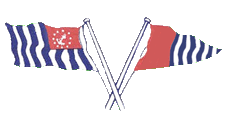 |
|
|
|---|---|---|
Flag and Etiquette Committee
|
Do It Right! |
|
|
|
||

Graphics Restrictions
Note: the flags on this page may not be drawn to exact scale.
Contents of this page
- Updated Flag Code for Recreational Boats
- Ensigns, Pennants, and Flags
- United States Ensign
- United States Yacht Ensign
- United States Power Squadrons® Ensign
- Canadian Power & Sail Squadrons Ensign
- United States Coast Guard Auxiliary Ensign
- Coast Guard Auxiliary Operational Ensign
- Yacht Club Burgee
- USPS Squadron Burgee
- Association Flags
- Owner's Private Signal
- Officer Flags
- USCG Auxiliary Officer Flags
- Union Jack
- Size of Flags
- Alternative Display Locations
- Making Colors
- Dressing Ship
- Courtesy Flags
- Foreign Guest Flags
- Half-Staffing Flags
Updated Flag Code for Recreational Boats
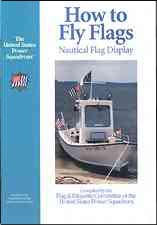 While the United States Flag Code, USC Title 4, Chapter 1, provides general guidelines for the display of the U.S. flag, nautical flag display is based on long-standing traditions that date back over 300 years.
While the United States Flag Code, USC Title 4, Chapter 1, provides general guidelines for the display of the U.S. flag, nautical flag display is based on long-standing traditions that date back over 300 years.
The United States Power Squadrons, the worlds largest boating educational organization, developed an updated code for displaying flags on boats in 1998. This code, devised in consultation with the U.S. Coast Guard, Coast Guard Auxiliary, New York Yacht Club, and other yachting authorities, eliminates confusion and will help you show proper respect for each flag and pennant you fly.
This code is primarily for use on private vessels because small craft are so different from large ships; yet it is flexible enough to accommodate the wide variation in construction of most modern pleasure craft. The code applies to all boaters, but has specific application to members of groups such as yacht clubs, the U.S. Coast Guard Auxiliary, and the United States Power Squadrons.
While points of honor have been established by long tradition, new configurations of boats, rigging and the like have modified these points. Using antennas, fishing towers, outriggers, sailboat backstays, portside halyards, and double hoisting are all new to the flag code. Even though traditionalists may think they are incorrect, these flag display techniques are appropriate today. If your boat's configurations requires you to use any of these techniques to fly your colors, do so, but follow this code to do so correctly.
The updated code, How to Fly Flags, Nautical Flag Display, is available from various marine suppliers around the country and from USPS Headquarters.
United States Ensign
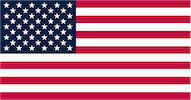
The U.S. national ensign, sometimes called "50-star" or "Old Glory," is the proper and preferred flag for all U.S. vessels. Your boat should wear it from 0800 until sunset, and when you enter or leave port during daylight or at night, weather and rig permitting. While in port, if you leave your boat and will not return before sunset, lower and stow the national ensign before you go.
The national ensign worn by a vessel must be the flag of her registry—not necessarily that of the owner or operator.
Generally, the national ensign should be displayed at the peak of the gaff, i.e., the outer end of the spar extending aft from the mast of your boat—if you boat has a gaff. If it does not, fly it from the flagstaff at your boat's stern. If your boat has an overhanging boom or an outboard motor, your flagstaff may be offset to starboard (preferably) from your boat's centerline.
On a sportfishing boat, where a stern staff might interfere with the gear, and vice versa, the practice is to fly the ensign from a halyard rigged amidships on the after part of the superstructure.
Marconi-rigged sailboats may fly the ensign from the leech of the aftermost sail (or from the back stay), approximately 2/3 the distance up its length. This puts it in about the same position it would occupy if the boat were gaff-rigged.
At anchor or made fast, the ensign should be flown from the stern staff of all boats. The U.S. national ensign has a 10:19 hoist/fly ratio.
U.S. Ensign Design Specifications
National ensigns from other countries
United States Yacht Ensign

The U.S. yacht ensign [definition] features a blue canton (the rectangle at the upper corner nearest the staff) having 13 white stars and a fouled anchor. Originally devised as a signal to identify documented yachts to relieve them of certain customs formalities, it is now flown on recreational boats of all types and sizes instead of the national ensign in domestic waters. Traditionally, the yacht ensign had a 10:19 hoist/fly ratio like the U.S. ensign. Today it is found with a 2:3 or 3:5 ratio. However, the preferred flag is the 50-star national ensign, especially since the yacht ensign must never be flown in international or foreign waters since it has no standing as a national ensign.
United States Power Squadrons Ensign
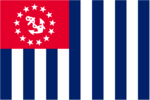 ®
®
The USPS ensign [definition] has a red canton containing 13 white stars surrounding a fouled anchor. The remainder of the flag contains thirteen vertical blue and white stripes. The USPS ensign has a 2:3 hoist/fly ratio. [Design] It is flown as a signal to others that the boat is commanded by an active member of USPS.
The preferred location for flying the USPS ensign is the starboard yardarm or spreader halyard. It may be worn there day and night. While in U.S. waters, the USPS ensign may be flown instead of the national ensign, and in any position and at any time appropriate to fly the national ensign.
The USPS ensign may be flown on boats displaying the United States Coast Guard Auxiliary (blue) ensign to indicate the owner is a member of both organizations, however when doing so, it may not be flown in lieu of the national ensign. The USPS ensign cannot be flown when the vessel is operating under U.S. Coast Guard orders and the USCGAux operational ensign is being worn.
Canadian Power & Sail Squadrons Ensign
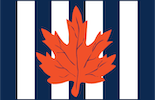
The Canadian Power & Sail Squadrons' ensign [definition] is a flag frequently seen on the United States northern border. The CPS ensign has a 3:5 hoist fly ratio. USPS has a close relationship with CPS that has resulted in many people holding membership in both organizations.
United States Coast Guard Auxiliary Ensign

The U.S. Coast Guard Auxiliary blue ensign [definition] may be worn on a boat that has been approved as a current facility by the organization. It is flown both day and night. By mutual agreement, it may be flown with the USPS ensign by those who are members of both organizations. In this case, the USPS ensign is flown from the starboard spreader, not in lieu of the national ensign. The current facility must wear the national ensign whenever the Auxiliary ensign is worn.
If your boat has a signal mast, fly the blue ensign at the masthead, replacing any other signal. Fly it at the main truck if your boat has two or more masts. On the other hand, if your boat does not have a mast, fly the Auxiliary ensign at the bow staff or antenna.
United States Coast Guard Auxiliary Operational Ensign

The USCGAux operational ensign (white with the orange and blue diagonal stripes of the U.S. Coast Guard) is worn in place of the blue ensign on USCGAux vessels while under Coast Guard orders or on patrol missions. When under orders, only the U.S. national ensign, the USCGAux operational ensign, and one officer flag may be flown. All other signals must be removed. The dimensions of the operational ensign should not be greater than those of the national ensign.
Yacht Club Burgee
Generally triangular in shape, although sometimes swallow-tailed, the yacht club burgee contains a unique design symbolic of the organization represented. If you boat is a mastless or single-masted yacht, fly your burgee from the bow staff. Boats without a bow staff should wear a burgee at the truck of a single-master yacht. On the other hand, if the truck is occupied with instruments or other conflicting gear, a pigstick can be affixed to a halyard so as to carry a flag above the truck. Alternatively, the burgee may be worn at a spreader halyard. If your boat has two or more masts, fly your burgee at the truck of the forward mast. Do not display more than one burgee at a time. The burgee your boat wears should be that of the group in whose activity you are participating, or whose harbor you are entering, if you are a member of that group. Otherwise, fly the burgee of your home organization. Each yacht club usually has rules that determine when their burgee should be flown.
USPS Squadron Burgee
A distinguishing USPS Squadron burgee which has been authorized by USPS may be flown in lieu of a club burgee and from the same positions. This burgee may be flown both day and night.
View squadron burgees and district flags
Association Flags
Flag's of associations, e.g., a cruising club or a USPS district, are generally rectangular and may be worn on a spreader halyard. Many flags or signals are flown from the spreader halyards but—usually—only one should be worn on each halyard. If your boat is rigged with one starboard halyard and one port halyard, fly the signal of superior dignity on the starboard side and the signal of lesser dignity on the port side. If you have more than one halyard on each side of your boat, fly the superior signal form the outboard starboard halyard, with other signals to its left, in order of decreasing dignity. They may be balanced, insofar as possible, starboard and port.
Owner's Private Signal
This is a personal flag, often called house flag. It is usually swallow-tailed, designed by the individual owner to depict a personal interest, hobby, family tradition, initials, or the like. A private signal should be a unique design and always in good taste. It should not include or be the ensign of a foreign country, nor duplicate a design previously adopted by someone else.
On a mastless vessel, fly your private signal from the bow staff. A single-masted vessel may wear it at the truck of the mast (replacing any other signal normally worn at that point) or from a spreader halyard.
Officer Flags
In most cases, officer flags are blue, red, white, or yellow signals the are rectangular or triangular. The officer flag is worn instead of the owner's private signal on all motor and sailing vessels except single-masted sailboats, where it is flown at the masthead in place of the club burgee. On motor boats without a signal mast, an officer flag may be flown from a radio antenna, preferably on the starboard side. Fly this flag either singly or under an associated ensign, that is, below the corresponding organizational ensign (not the national ensign or the yacht ensign.)
The only other officer flag that may be worn simultaneously with the owner's or captain's officer flag is that of a visiting officer of higher rank than the officer commanding the vessel. The visiting officer's flag may be flown from the bow staff (in place of the burgee) or from the port spreader halyard. The starboard-side halyard positions belong to the flag of the owner/captain; the port side halyard positions belong to the visitors flags.
USCG Auxiliary Officer Flags
The flag of a USCG Auxiliary officer flies day and night when the officer is on board. On a vessel without a mast, it is flown at the bow staff in place of the USCG Auxiliary ensign; on a vessel with a mast, it is flown at the starboard spreader. Past officer burgees are displayed in the same manner.
Only one officers pennant may be flown at a time, and an incumbent officers pennant invariably takes precedence.
Union Jack

A rectangular blue flag with 50 stars-the upper quadrant of the National Ensign nearest the hoist, properly referred to as a canton. It is worn most often by government vessels—rarely by private vessels. It may be flown only when not underway at the jack staff of yachts with more than one mast, and only on Sundays, holidays, or when dressing ship. The exterior dimensions of the union jack should be equal to the respective exterior dimensions of the union on the national ensign being flown.
Size of Flags
Flags are often too small. When your purchase your flags, use the following guidelines, rounding up to the next larger commercially available size when necessary.
The national ensign flown at a flag staff at the stern of your boat should be one inch on the fly for each foot of overall length.
All other flags such as club burgees, officer flags, and private signals for use on sailboats should be approximately 1/2 inch on the fly for each foot above the waterline of the tallest mast on the boat. (That is, if the tope of the mast is 30 feet above the waterline, these other flags should be 15 inches on the fly.) On powerboats, these flags should be 5/8 inch on the fly for each foot of overall length. The shape and proportions of pennants and burgees will be prescribed by the organization to which they relate. A union jack should be the same size as the canton of the national ensign being flown from the flag staff.
Many foreign ensigns—courtesy flags—sold in stores are not manufactured to correct proportions. For instance, the flags of all former British Commonwealth countries, including Canada, Bermuda, the Bahamas, and the British Virgin Islands, are correctly proportioned 1:2, i.e., the fly is twice the length of the hoist. As a matter of interest, the United States flag is correctly proportioned 10:19 (nearly 1:2), not 3:5 as is commonly available.
Alternative Display Locations
Avoid flying more than one ensign from a single halyard or antenna. On the other hand, when the preferred positions for an organizational burgee or officer flag are not available, you may fly these from spreader halyard, with more than one on a hoist if necessary. In such instances however, you must observe the proper order of precedence. If you must multiple-hoist these flags, no more than one flag of the same type or stature may be flown from the same halyard. Each flag must be senior to the one below it, except that the officer-ion-charge pennant may be placed above the officer flag when it is appropriate to do so. When neither the preferred location nor a spreader halyard is available, a radio antenna may be used. Never fly any other flag on the same halyard as, or on a halyard to starboard of, a courtesy flag
Making Colors
Colors are made each morning at 0800; as mentioned, at yacht club and similar organization docks or anchorages, this may be signaled by a morning gun. The national ensign or yacht ensign is hoisted at the stern (or set in place on its staff). This is followed, as applicable, by a foreign ensign (courtesy flag), a club or squadron burgee, organizational flags, an officer flag or private signal and then by any other signals not already fling, such as a guest flag.
At sunset, colors not properly flown on a day-and-night basis should be lowered in reverse sequence, the ensign at the stern always being the last to be secured.
If you fly the yacht ensign (or other authorized ensign) in lieu of the U.S. ensign, raise and lower it as if it were the U.S. national ensign.
Dressing Ship
On national holidays, at regattas, and on other special occasions, yachts often "dress ship" with International Code of Signal flags. The ship is dressed at 0800, and remains so dressed until evening colors (while at anchor only, except for a vessel's maiden and final voyages, and participation in a marine parade or other unique situation).
In dressing ship, the national ensign is hoisted at the stern staff (and the Union Jack may be displayed at the jack (bow) staff on government vessels). A rainbow of flags of the International Code is arranged, reaching from the water line forward to the water line aft, by way of the bowsprit end (or stem if there's no bowsprit) and the masthead(s). Flags and pennants are bent on alternately, rather than in any indiscriminate manner. Since there are twice as many letter flags as numeral pennants, it is good practice, as in the Navy, to follow a sequence of two flags, one pennant, two flags, one pennant, throughout. The sequence recommended here provides a harmonious color pattern throughout:
Starting from forward: AB2, UJ1, KE3, GH6, IV5, FL4, DM7, PO Third Repeater,
RN First Repeater, ST Zero, CX9, WQ8, ZY Second Repeater.
Old and New USCGC Mackinaws Dressing Ship
Courtesy Flags
When you visit foreign water, your boat should display a courtesy flag (the civil ensign of the country you are visiting) whenever your U.S. national ensign (the USPS ensign or the yacht ensign should not be displayed in foreign waters) is displayed. (The USPS ensign and U.S. yacht ensign should not be worn in foreign waters)
If your vessel is mastless, it should wear this "courtesy flag" at the bow, in lieu of a squadron or club burgee, or on a starboard antenna strong enough to support it. It your vessel has one or more masts, display it single-hoisted at the outboard signal halyard of the main starboard spreader. Move any flag normally flown there to the inboard starboard halyard or, if your boat has only one halyard per side, to the port spreader halyard.
The customs observed in various foreign waters differ from one another. Try to learn the correct procedure for the country you are entering. For example, is some countries it is customary to fly the courtesy flag only after the quarantine flag (the yellow 'Q' flag) and the vessel has been granted pratique by the appropriate authorities.
Do not fly a foreign courtesy flag after you have returned to U.S. waters. It is not to be used as a badge of accomplishment for having cruised to another country.
Foreign Guest Flags
When a foreign guest is aboard, you may display the ensign of the guest's country from the bow staff or outboard port spreader. Should more than one such guest flag be appropriate, wear them on spreader halyards from port to starboard in the alphabetical order of their countries' names in the English language.
Half-Staffing Flags
The only authorities who may direct that all national ensigns be flown at half-staff (sometimes called "half-mast) are the President of the United States or the governor of a state. The length of time at which the ensign is to be flown at half-staff is determined by the deceased person's position and the directive of the president or governor. This normally lasts from 1 or 2 days to as many as 30 days.
A commodore, commander, civic association president, or corresponding official of a similar organization may order his organization's flag flown at half-staff to honor a member who has died. A club burgee on a sail or signal mast is a half-staff when ti is even with the man spreader or yardarm.
On Memorial day, the national ensign is properly flown at half-staff until 1200.
When you fly your national ensign at half-mast, hoist it smartly as high as you can (sometimes referred to as "chock-a-blocked") or "two-blocked"). Then lower it ceremoniously to the half-mast position. When you are taking it down at the end of the day, smartly two-block it again and then lower it ceremoniously from there. When the ensign is at half-mast, all other flags remain two-blocked.
At the stern of a vessel, or on a flagpoles ashore, the half-mast position is approximately three-fourths the height of the truck. If the flagpole has a yardarm, the half-mast position is where the top of the flag is level with the yardarm.
When it is half-masted ashore, fly only a private signal or club burgee at masthead of a gaff-rigged mast with it.
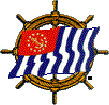
|
|
